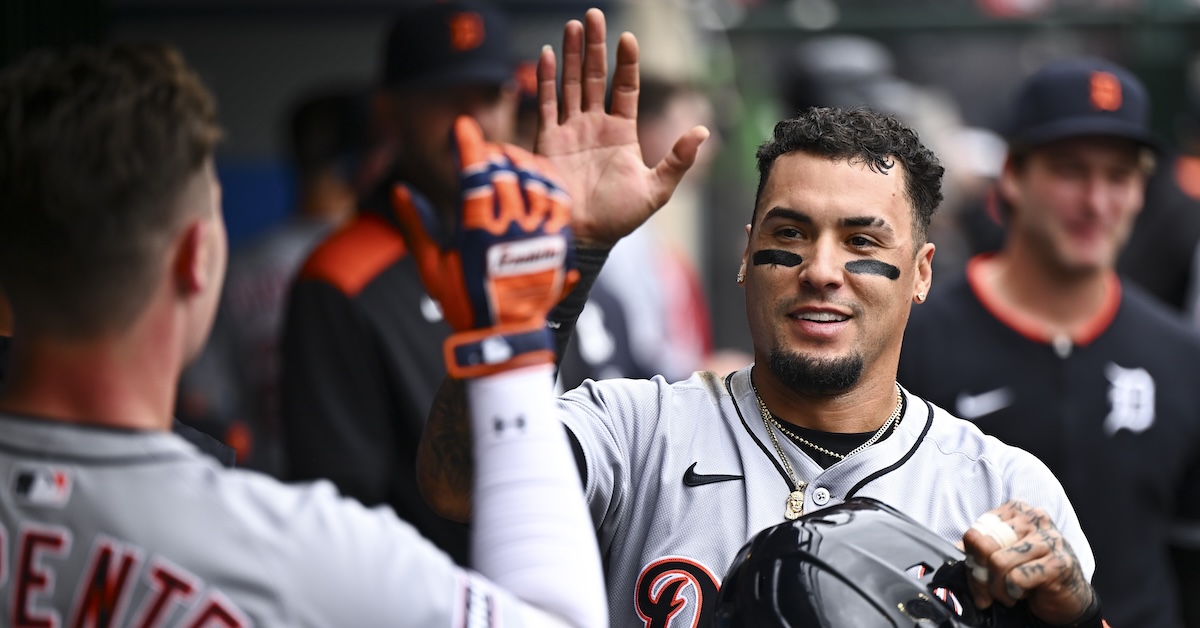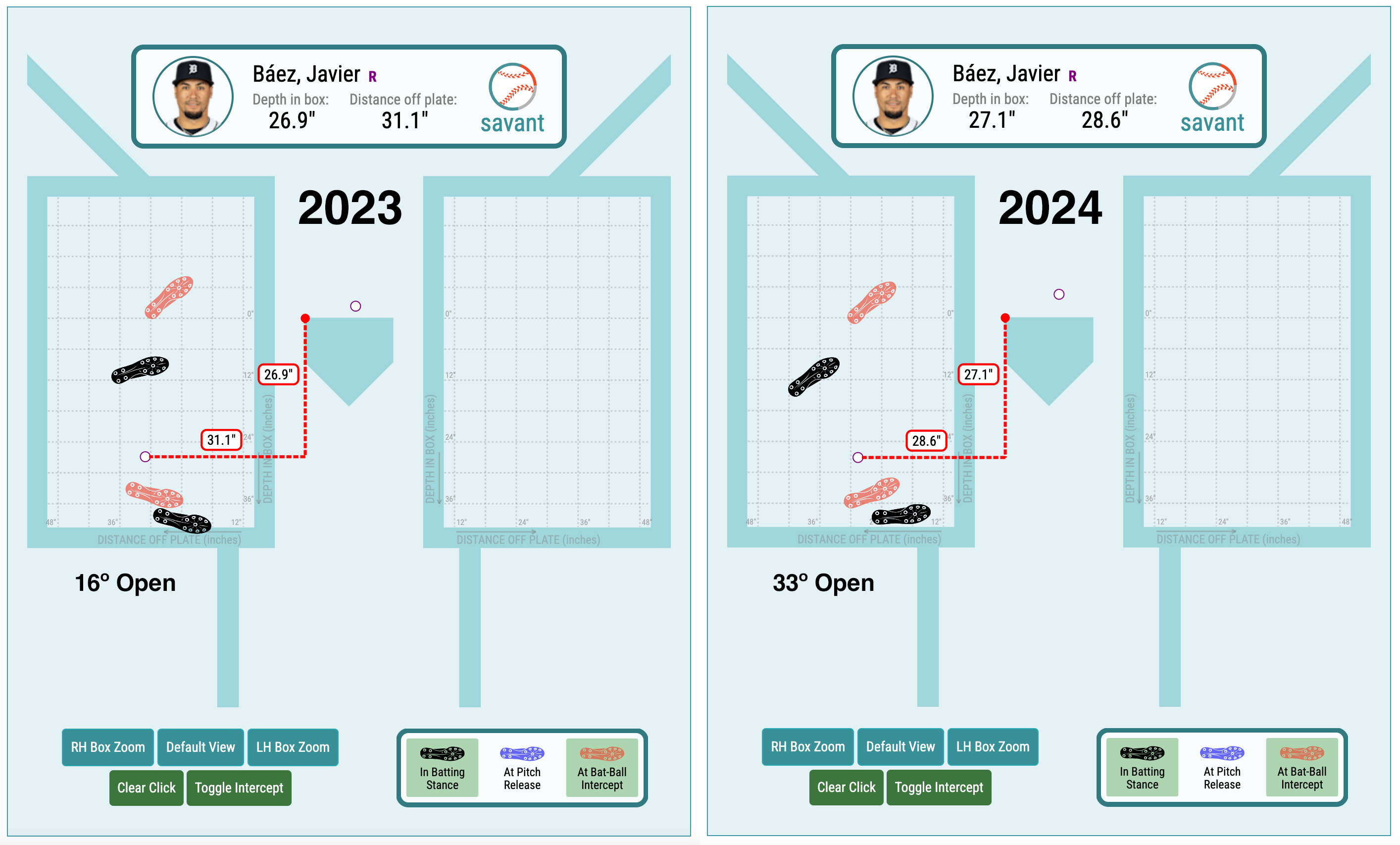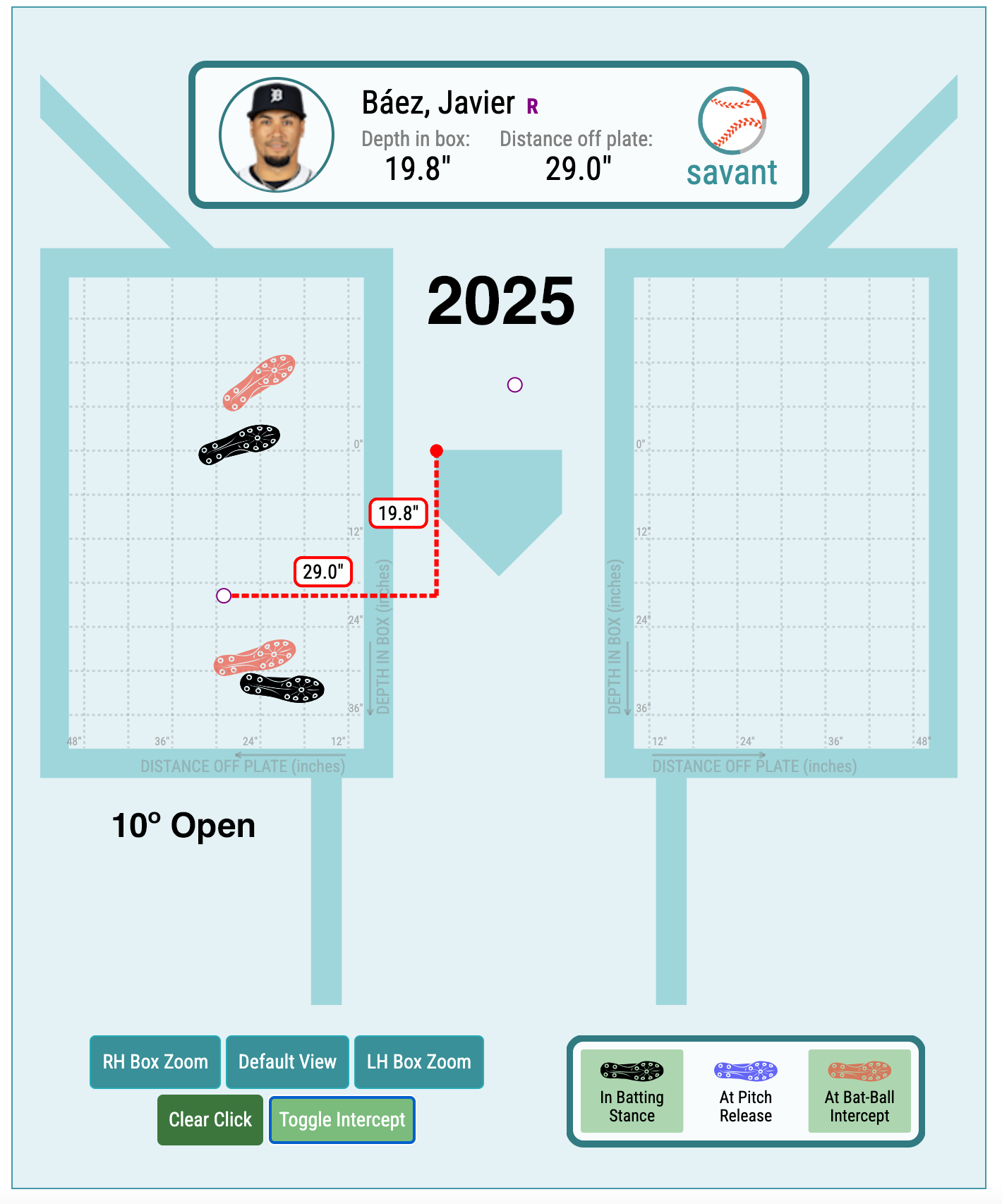The New-Look Javier Báez Is Fun Again

Through his first three seasons in Detroit, Javier Báez was largely a disappointment, with a combination of flashy defense and free swinging that yielded such diminishing returns that he sank below replacement level while battling injuries last year. He missed the late-season run that helped the Tigers capture a Wild Card spot, and as spring training opened, a full-time place in their lineup wasn’t guaranteed. Amid a rash of injuries to other Tigers, he’s not only split his time between center field — a position he hadn’t played in a regular season game before — third base, and shortstop, he’s been a productive hitter thanks to better health and some adjustments to his swing.
Even while going hitless on Friday and Sunday against the Rangers, the 32-year-old Báez is hitting .300/.336/.455 with three homers and a 127 wRC+. The peripherals underlying that are admittedly shaky, and he’s walking just 3.4% of the time, but thanks to positive defensive contributions at comparatively unfamiliar positions, he’s fourth among the team’s position players with 1.1 WAR — and he’s done it for a team that has the AL’s best record (26-15, .634) and largest division lead (2 1/2 games). For the first time in awhile, watching him is a whole lot of fun.
The Tigers signed Báez to a six-year, $140 million deal in November 2021, after he’d split his season between the Cubs and the Mets (who dealt away Pete Crow-Armstrong in the package to acquire him) — a strong one in which he posted a 117 wRC+ and 4.1 WAR. He was serviceable at best during his first season in Detroit (.238/.278/.393, 89 wRC+, 2.0 WAR) but sank to .222/.267/.325 (63 wRC+) with 0.8 WAR in 2023, then hit just .184/.221/.294 (43 wRC+) in 80 games last year. He missed nearly a month in June and July due to lumbar inflammation; the problem flared up again in August, accompanied by right hip inflammation. Under the belief that the Tigers were going nowhere at 62-66, he played his last game of the season on August 22 before undergoing surgery. Without their highest-paid player — a coincidence that was tough to miss given his underperformance — the Tigers went a major league-best 24-10 and snatched the third AL Wild Card spot, their first playoff berth in a decade.
The road to Báez’s recovery began with arthroscopic surgery on his right hip on September 3. The procedure, which he had put off for several months, addressed both his hip and lower back woes, which had factored into his 2022 and ’23 struggles, hampering his flexibility and his ability to rotate during his swings. He began his rehab during the Tigers’ run. “It was very hard,” he said in February, shortly after reporting to spring training. “After the surgery, I was working out like I was coming back for the playoffs, and I still had four months to go.”
“Báez said he could feel a difference soon after surgery. He was able to sit up straighter, feel more balanced,” The Athletic’s Cody Stavenhagen wrote in mid-February, a point at which Báez had been swinging at full effort for two weeks and fielding groundballs at shortstop but was not yet cleared to run. Given the late-season emergence of shortstop Trey Sweeney, whom the Tigers acquired from the Dodgers in the Jack Flaherty deal ahead of the trade deadline, it appeared Báez might be limited to platoon duty at what had been his regular position. Under manager A.J. Hinch’s plan, he would have to call upon the versatility that he showed early in his career with the Cubs in order to find playing time.
Báez bought in. ““If I stay healthy, I’ll do whatever, man,” he said in mid-April. “I can even catch if you need me. And A.J. knows it.”
By the beginning of March, the Tigers’ depth chart in center field had taken some hits, with Parker Meadows diagnosed with a nerve issue in his right (throwing) arm and Matt Vierling suffering a rotator cuff strain. Wenceel Pérez emerged as the most likely candidate for starts while those two were down, but the team also began working Báez into backfields scrimmages in center, a position he’d played as a child and then dabbled at during the 2015–16 Puerto Rican Winter League season and the following spring with the Cubs. The late February addition of free agent Dexter Fowler curbed that experiment, and he wasn’t needed to man the middle pasture for Chicago, but the experience wasn’t forgotten. After Báez made his Grapefruit League debut in center for the Tigers on March 23, he said, “Honestly, I never ended my desire to play center.”
When Pérez was sidelined by lower back inflammation in late March, the Tigers turned to light-hitting superutilityman Ryan Kreidler to be the team’s Opening Day center fielder. He started 14 of the team’s first 22 games there, with Riley Greene — who played 27 games at the position last year and 199 from 2022–24 — making the rest despite the Tigers’ preference to keep him in left field given his injury history. Báez started at shortstop on Opening Day but made just five additional starts there over that 22-game span, compared to nine at third base (where he hadn’t played a regular season game since 2019) in a mix with Zach McKinstry and Andy Ibáñez.
By that point, both Meadows and Perez were on the 60-day injured list. On April 21, the team recalled third baseman Jace Jung from Triple-A Toledo, optioned Kreidler, and gave Báez his first start in center field. To that point, he had made a few uneventful defensive cameos there and had hit a thin .268/.305/.321 (81 wRC+). He took to the new position quickly; the over-the-shoulder grab included in the highlight reel above happened in just his third start out there on April 23.
On the offensive side, Báez has gotten to this point by making significant adjustments. He’s closed his stance, lowered his hands, shortened his swing, and cut down his chase and whiff rates. If he’s not hitting the ball all that hard, he’s at least squaring it up with greater consistency.
Statcast’s new batting stance data, which goes back to the second half of 2023, shows Báez trying to find something that worked but then abandoning it when it didn’t. He went from a stance that was open by 16 degrees in 2023 to one open by 33 degrees last year. He’s closed that down to 10 degrees this year, with the distance between his feet increasing from 29.8 inches to 32.5 inches over that span. Notably, he’s also moved closer to the pitcher, from a depth of 27.1 inches in the box last year to 19.8 inches this year, and his average point of contact has increased from 4.6 inches in front of the plate to 9.1. Here’s a comparison between late 2023 and ’24:

And here’s 2025:

As for the position of his hands, Statcast doesn’t have that data, at least not publicly. Below is a supercut of three extra-base hits from Comerica Park over the past three seasons, chosen so that they provide at least a somewhat consistent angle to illustrate the way Báez opened his stance and closed it. But first, here’s a trio of frame grabs from just before Báez began his swing, illustrating how he’s lowered his hands over this timespan:

And now the video:
Báez isn’t swinging as hard as he used to, and isn’t taking his fast swing as often; in fact, his frequency of fast swings is less than half what it was in late 2023 or ’24. He’s trimmed about half a foot off the length of his swing, which as of last year was in a virtual tie with Giancarlo Stanton for the majors’ longest:
| Season | Avg Bat Speed | Fast Swing% | Length | Squared-Up Swing% | Blast Swing% |
|---|---|---|---|---|---|
| 2023 | 74.1 | 45.0% | 8.5 | 19.8% | 12.1% |
| 2024 | 74.8 | 49.4% | 8.6 | 21.3% | 12.4% |
| 2025 | 72.1 | 18.5% | 8.1 | 23.9% | 11.4% |
By swinging from his heels less, Báez has cut his swinging strike rate to a career-low 13.5%, down from 14.8% last year and 16.7% in 2023; it was as high as 21.7% in ’21. In each of the past two seasons, he chased 42.6% of pitches outside the zone, but he’s cut that to a slightly more reasonable 37.2%, which still places him in the fourth percentile among qualifiers. His 24.1% strikeout rate is on par with last year, and while his paltry 3.4% walk rate actually represents a drop from last year’s 4.2%, it’s not a career low.
With his shorter swing, Báez is making more frequent contact, particularly in the zone, where his 86.4% contact rate is a career high, seven percentage points above his career mark. As I noted above, he’s not hitting the ball all that hard:
| Season | EV | LA | Brl% | HH% | AVG | xBA | SLG | xSLG | wOBA | xwOBA |
|---|---|---|---|---|---|---|---|---|---|---|
| 2023 | 88.0 | 9.3 | 5.1% | 38.8% | .222 | .234 | .325 | .355 | .261 | .279 |
| 2024 | 88.3 | 11.2 | 7.8% | 39.8% | .184 | .222 | .294 | .345 | .224 | .264 |
| 2025 | 87.8 | 7.0 | 6.1% | 35.4% | .300 | .241 | .455 | .380 | .348 | .288 |
Báez hasn’t posted an average exit velo of 90 mph or above since 2021, when he accompanied a 90.1-mph average with a 13.4% barrel rate and a 45.2% hard-hit rate; he offset that by striking out 33.6% of the time, but at that point, he was still an above-average hitter. Now, he’s hitting more groundballs (a career-high 51.2%), but at least when he does elevate the ball, his 21% pulled air rate is also a career high and punches up that batting line a bit.
As you can see above, Báez’s expected stats aren’t far removed from last year. He is trending upwards, in that since taking over the center field job on April 22, he’s averaged an 89.7 mph exit velo with a 10% barrel rate, a 42.5% hard-hit rate, and a .304 xwOBA. If he could maintain something in that neighborhood, he’d be fine — a reasonably valuable player given his defense (he’s already at 4 DRS and 2 FRV in 136 innings in center, for what it’s worth).
How this will all fit together when the Tigers’ other center field options are healthy is unclear. Vierling spent the past week on a rehab assignment with Toledo, homering twice while being limited to DH duty before making his defensive debut in right field on Sunday. He’s expected to spend another week with the Mud Hens, checking off boxes for back-to-back starts in right and getting reps at third base. “We just want to slowly but effectively mirror what he’s going to do when he comes back here,” said Hinch on Sunday. Pérez and Meadows aren’t eligible to be activated until May 23 and May 26, respectively. Neither has begun a rehab assignment yet, though Pérez is more likely to return in late May, with early June a more realistic target for Meadows. As for the current infield, Sweeney has been solid, hitting .254/.329/.365 (102 wRC+), and McKinstry has been better than that (.274/.370/.395, 121 wRC+), while the recently recalled Jung has struggled (.100/.234/.100 in 47 PA) and may be vulnerable to a demotion.
Given how thin the Tigers have been stretched by injuries, and how close to a sunk cost Báez appeared to be just a few months ago, a crowded roster is a nice problem to contemplate. Báez may not maintain his current pace at the plate, but the fact that he’s making positive contributions to a winning team again bodes well for the Tigers.
Brooklyn-based Jay Jaffe is a senior writer for FanGraphs, the author of The Cooperstown Casebook (Thomas Dunne Books, 2017) and the creator of the JAWS (Jaffe WAR Score) metric for Hall of Fame analysis. He founded the Futility Infielder website (2001), was a columnist for Baseball Prospectus (2005-2012) and a contributing writer for Sports Illustrated (2012-2018). He has been a recurring guest on MLB Network and a member of the BBWAA since 2011, and a Hall of Fame voter since 2021. Follow him on BlueSky @jayjaffe.bsky.social.
Slight edit:
Assuming this should be contact rate? An 86.4% strikeout rate is pretty high!
Even Joey Gallo didn’t swing and miss that much!
To be honest, it has felt like 86.4% at times watching as a die-hard Tigers fan.